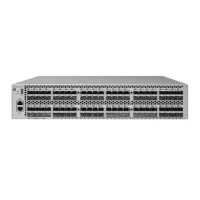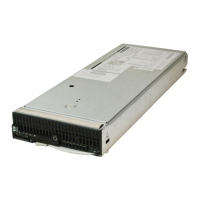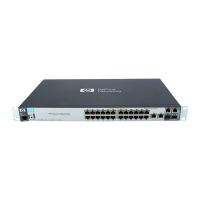540 Fabric OS Administrator’s Guide
53-1002745-02
Trunk Area and Admin Domains
22
Rx: Bandwidth 16.00Gbps, Throughput 1.67Gbps (12.12%)
Tx+Rx: Bandwidth 32.00Gbps, Throughput 3.33Gbps (12.12%)
3: 10-> 10 10:00:00:05:1e:81:56:8b 1 deskew 15 MASTER
11-> 11 10:00:00:05:1e:81:56:8b 1 deskew 15
Tx: Bandwidth 4.00Gbps, Throughput 1.66Gbps (48.45%)
Rx: Bandwidth 4.00Gbps, Throughput 1.67Gbps (48.48%)
Tx+Rx: Bandwidth 8.00Gbps, Throughput 3.33Gbps (48.46%)
4: 12->892 10:00:00:05:1e:46:42:01 3 deskew 15 MASTER
13->893 10:00:00:05:1e:46:42:01 3 deskew 15
Tx: Bandwidth 16.00Gbps, Throughput 1.67Gbps (12.12%)
Rx: Bandwidth 16.00Gbps, Throughput 1.66Gbps (12.11%)
Tx+Rx: Bandwidth 32.00Gbps, Throughput 3.33Gbps (12.11%)
Trunk Area and Admin Domains
Ports from different Admin Domains (ADs) are not allowed to join the same Trunk Area (TA) group.
The portTrunkArea command prevents the different ADs from joining the TA group.
When you assign a TA, the ports within the TA group have the same index. The index that was
assigned to the ports is no longer part of the switch. Any domain,index (D,I) AD that was assumed
to be part of the domain may no longer exist for that domain because it was removed from the
switch.
Example of how Trunk Area assignment affects the port domain,index
If you have AD1: 3,8; 3,9; 4,13; 4,14 and AD2: 3,10; 3,11, and then create a TA with index 8
with ports that have index 8, 9, 10, and 11, then index 9, 10, and 11 are no longer with domain
3. This means that AD2 does not have access to any ports because index 10 and 11 no longer
exist on domain 3. This also means that AD1 no longer has 3,9 in effect, because index 9 no
longer exists for domain 3. Port 3,8, which is the TA group, can still be seen by AD1 along with
4,13 and 4,14.
If a port within a TA is removed, the index is added back to the switch. For example, the same
AD1 and AD2 with TA 8 holds true. If you remove port 9 from the TA, it adds index 9 back to the
switch. That means port 3,9 can be seen by AD1 along with 3,8, 4,13, and 4,14.
ISL trunking over long-distance fabrics
In long-distance fabrics, if a port speed is set to autonegotiate, then the maximum speed, which is
16 Gbps, is assumed for reserving buffers for the port. If the port is running at only 2 Gbps, this
wastes buffers. For long-distance ports you should specify the port speed instead of setting it to
autonegotiate.
In addition to the criteria listed in “Supported configurations for trunking” on page 535, observe
the following criteria for trunking over extended fabrics:
• It is supported only on switches running Fabric OS v6.1.0 and later.
• Extended Fabrics and Trunking licenses are required on all participating switches.
• When configuring long distance, you must configure the portCfgLongDistance
--vc_translation_link_init parameter to be the same on all ports in an extended fabric.

